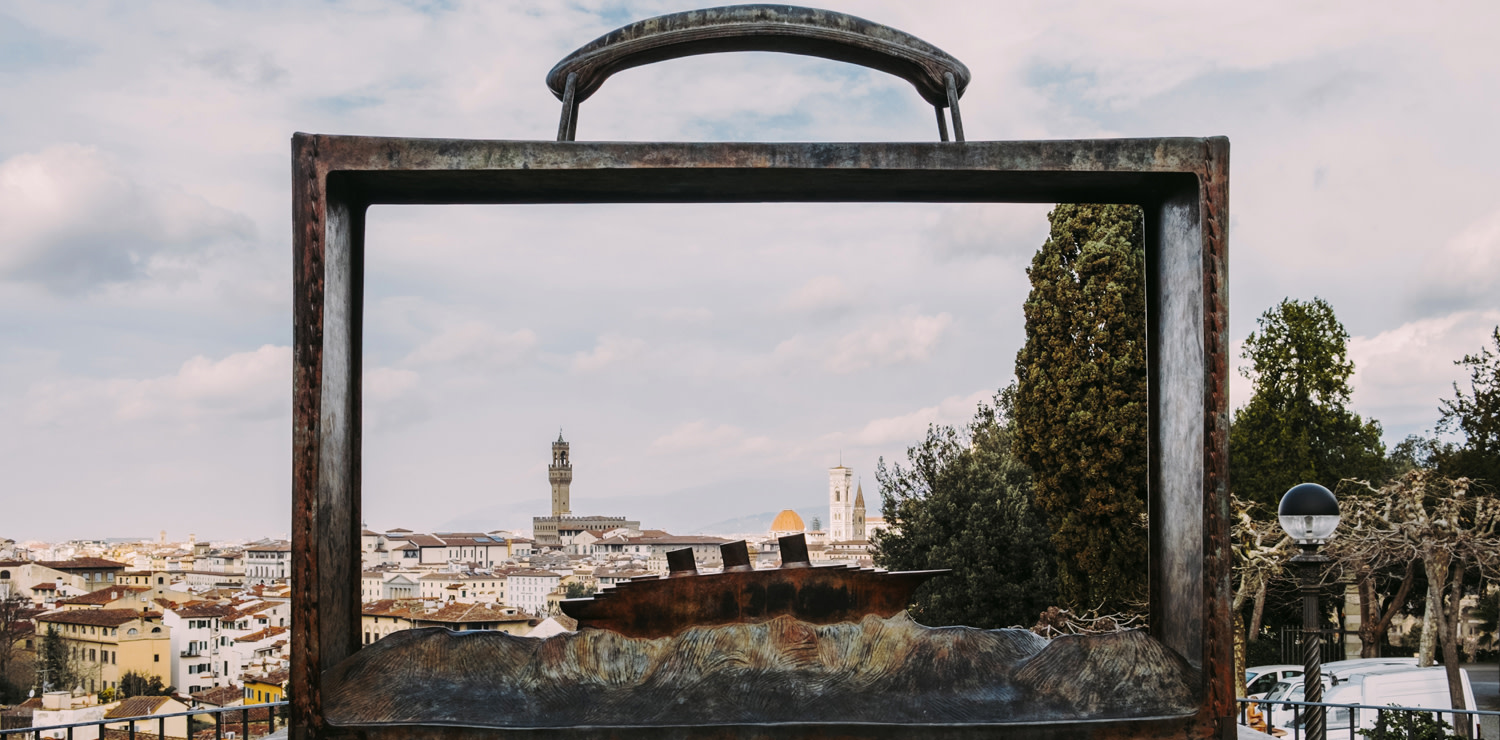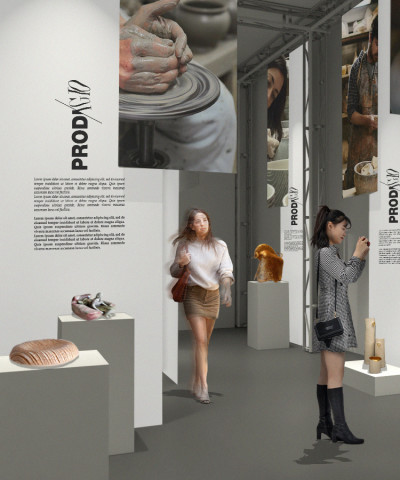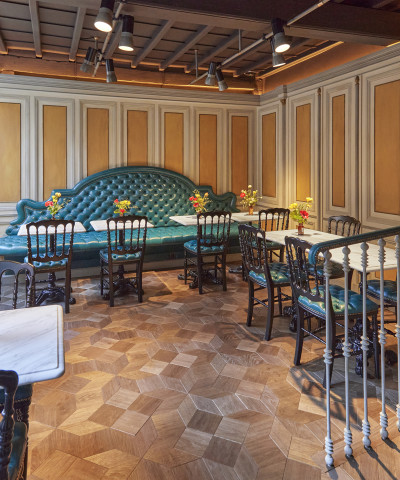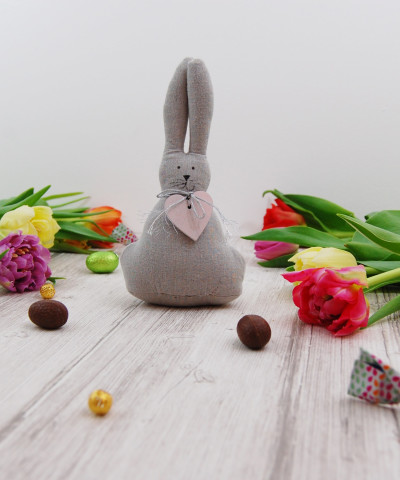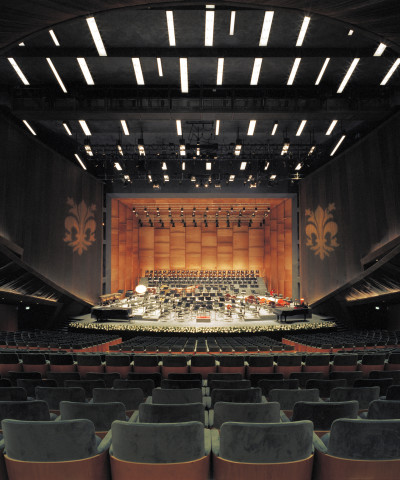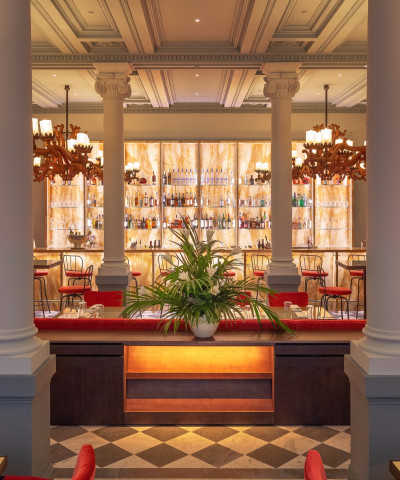Contemporary art in Tuscany
The most beautiful open-air artworks and installations in Florence and beyond
Contemporary art in Tuscany goes outside the four walls of museums and is studded with incredible works and installations streets, squares, facades and other iconic places of cities and villages.
From the Florentine plain to the towns along the Apuan Coast, from Versilia to Maremma, from Valdera to Valdelsa, from Chianti to Mount Amiata’s hillsides. In Florence, public art is mostly installed at the entrance to the city, juxtaposed with the city’s glorious history. Prato is the first example of a permanent “form” of public art incorporated in the city’s urban and cultural fabric and which now serves as a contemporary art workshop. In Pistoia, the public art “movement” was pushed for by the Gori collection in Celle. In Pontedera, it has taken on a local identity. In Peccioli, it has led to the creation of an open-air workshop.
Pietrasanta created an internationally-renowned “park” of sculptures. Leghorn and Pisa boast important works of art. From Vinci to Certaldo, from Poggibonsi to San Gimignano, from Colle Val d’Elsa to Siena, from San Casciano Val di Pesa to Impruneta, the heart of Tuscany beats to the rhythm of great contemporary art.
Here's what you mustn't miss, taken from the new guide Contemporary Tuscany, published by us at Gruppo Editoriale, edited by Stefano Pezzato with the Centro Pecci di Prato, published with the support of Regione Toscana and Toscana Promozione Turistica.
FIRENZE
 Igor Mitoraj, Tindaro screpolato, 1998. Boboli Gardens
Igor Mitoraj, Tindaro screpolato, 1998. Boboli GardensTuscany’s regional capital, a UNESCO World Heritage Site, boasts many contemporary art exhibitions and installations in historic locations such as Palazzo Strozzi, Forte del Belvedere and the Boboli Gardens, which house a huge mythological sculpture by Igor Mitoraj. The city offers also a number of public works of art installed, in the eighties, in some of the city’s busiest and most traffic-congested spots: the “bi-directional” sculpture by Michelangelo Pistoletto at the Porta Romana Gate; the St. John sculpture by Giuliano Vangi near Ponte Vecchio; the monumental “Sun for Galileo” stele by Giò Pomodoro at Porta San Niccolò; the “enchanted” figures by Jean-Michel Folon in the panoramic Rose Garden and opposite the Tuscany Hall theater. In addition, the big-sized sculptures by Corrado Cagli and Eliseo Mattiacci, a “rhinoceros” moulded by Davide Rivalta around the new Maggio Fiorentino Theatre, and the symbolic Paloma by Fernando Botero in front of the airport.
PRATO
 Henry Moore, Square Form with Cut, 1969-71
Henry Moore, Square Form with Cut, 1969-71The city which houses the Pecci Center, the region’s major contemporary art museum, is also home to a number of permanent works: Henry Moore’s “Square Form with Cut” on Piazza San Marco; the symbolic sculpture by Jacques Lipchitz on Piazza del Comune; new religious works by Robert Morris and Giuseppe Spagnulo in the Cathedral of Santo Stefano; an evocative “hot-air balloon” fountain by Marco Bagnoli on Piazza Ciardi; original light works by Fabrizio Corneli and Carlo Bernardini near the Emperor’s Castle. Other urban marks are the post-modern tribute to Paolo Uccello by Ben Jakober & Yannick Vu on Via Pomeria and Loris Cecchini’s modular installation at the entrance to the Area ex Campolmi, which now houses the Lazzerini Library and the Textile Museum. Particularly interesting is the urban project on Piazza dell’Immaginario, which features photographic works in the open, in the so-called “Chinese Quarter” beyond the ancient Porta Pistoiese.
PISTOIA
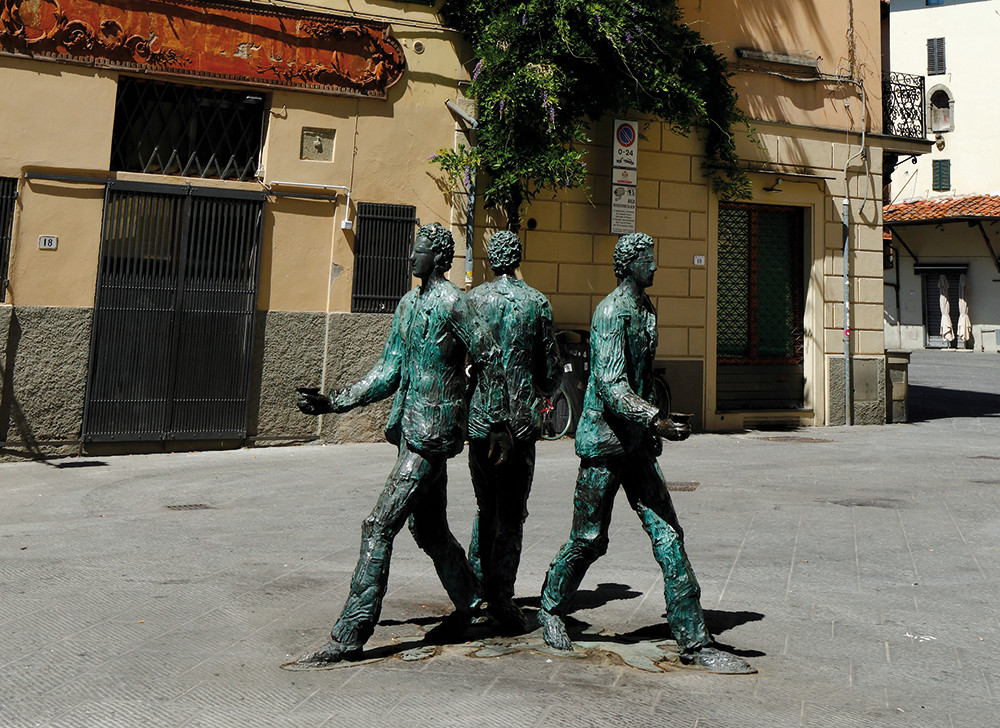 Roberto Barni, Il giro del sole, 1996
Roberto Barni, Il giro del sole, 1996Italy’s 2017 Capital of Culture, Pistoia features a well-established contemporary art scene. In addition to Alberto Burri’s big-sized sculpture in Santomato, the symbol of the extraordinary Gori collection at Villa Celle, the city center showcases works connected with the Palazzo Fabroni museum, such as the sculptures by Roberto Barni on Piazza dell’Ortaggio, the lunar installation by Gianni Ruffi on Piazza Giovanni XXIII, the large artistic windows by Umberto Buscioni in the ancient Church of San Paolo, Renato Ranaldi’s universal symbol along the walls of Via Fonda. Worth mentioning are also the imposing work by Anselm Kiefer at the San Giorgio Library, in the Area ex Breda, and the Flying Garden on Via degli Armeni with ludic works by artist Luigi Mainolfi, designer Alessandro Mendini and Gianni Ruffi.
PIETRASANTA
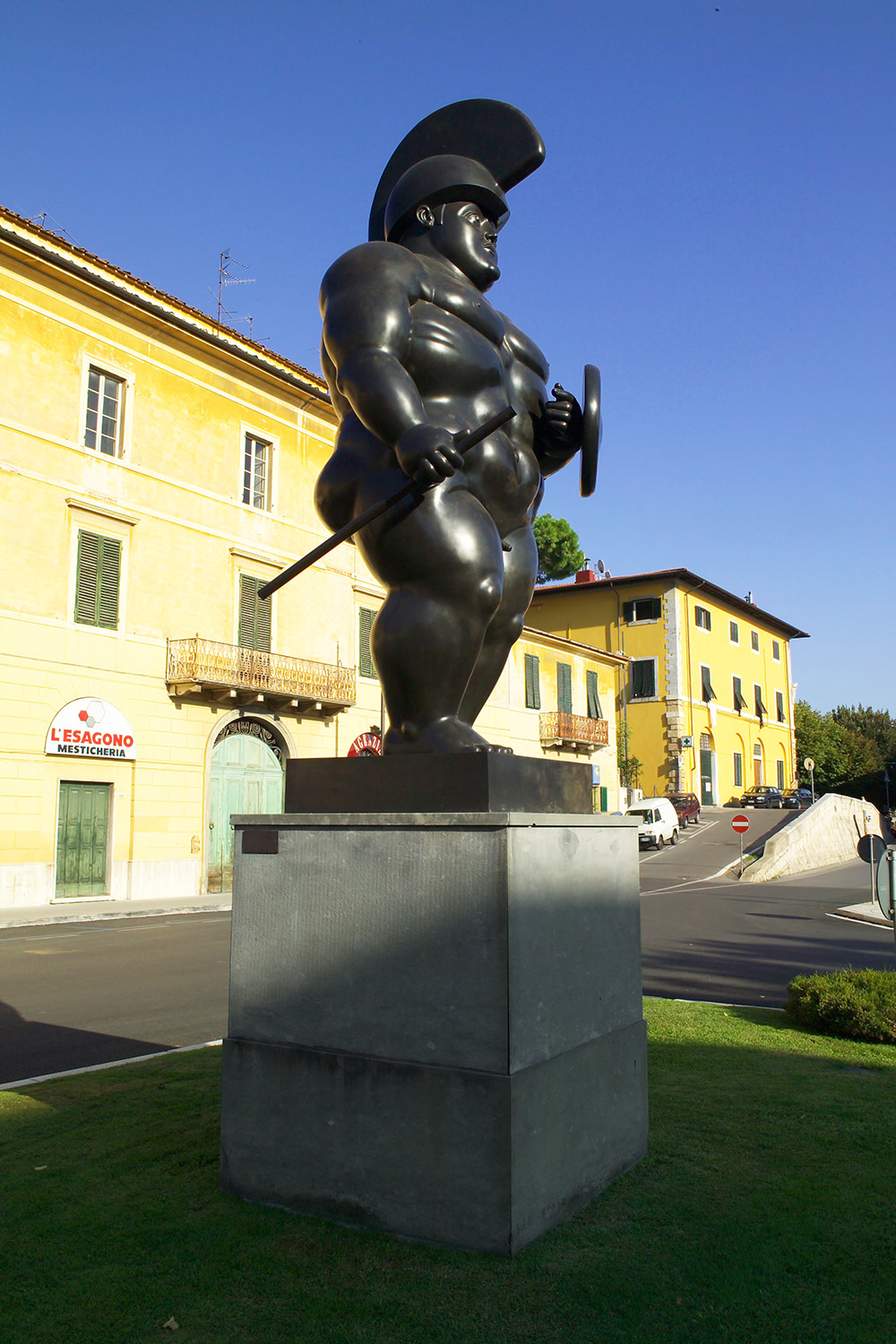 Fernando Botero, The Roman Warrior, 1992
Fernando Botero, The Roman Warrior, 1992A small town of the Versilia area known for its artistic community which gained it the appellation of “Little Athens”, Pietrasanta is famous for its bronze and marble workshops which attract artists and art lovers from all over the world. In addition to the Museo dei Bozzetti, which documents the local sculpting activity and production, and the many art exhibitions in public and private spaces, the town has been housing, since the nineties, the International Park of Contemporary Sculpture, which showcases permanent works by artists such as Fernando Botero, Pietro Cascella, Jiménez Deredia, Jean-Michel Folon, Francesco Messina, Igor Mitoraj, Costantino Nivola, Jorgen Sorensen, Helidon Xhixha, Kan Yasuda, all considered to be among the world’s greatest contemporary sculptors. Several sculptures adorn the Versiliana Park in Marina di Pietrasanta, which also hosts a number of cultural activities and theater events.
LIVORNO
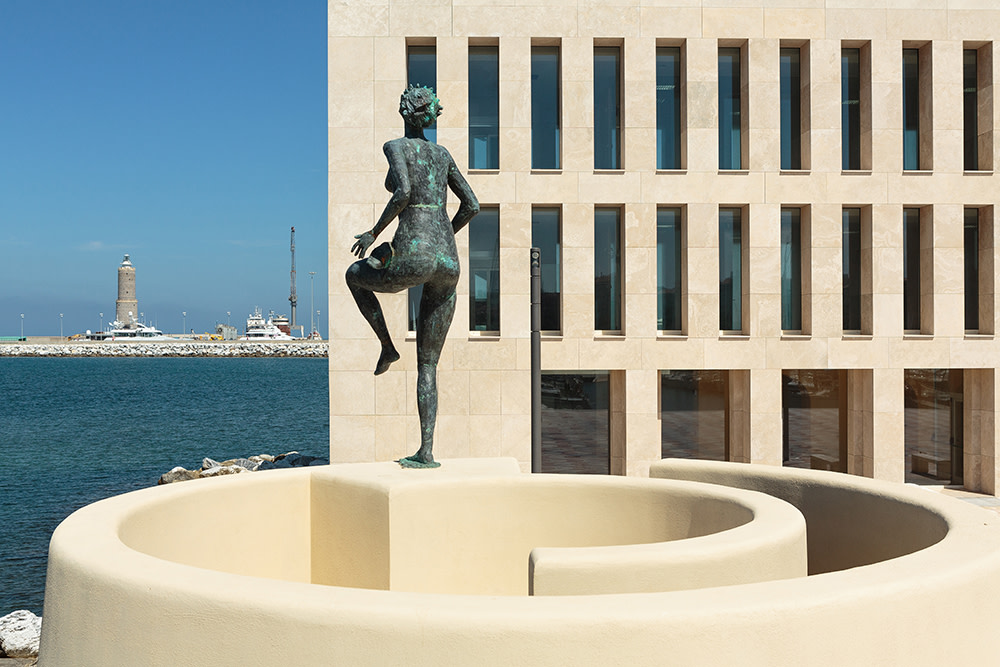 Sandro Chia, Bagnante (Bather), 2016. Scoglio della Regina
Sandro Chia, Bagnante (Bather), 2016. Scoglio della ReginaA gateway to Tuscany’s sea and a historic free-trade zone, Leghorn supported the pilot project that led to the creation of the Progressive Contemporary Art Museum, established in the seventies and then merged with the renovated Museo della Città (City Museum), located in the downtown neighborhood of Venezia Nuova. The city houses significant works of contemporary public art, such as the bronze nude female statue dancing by the sea by Sandro Chia, which marked the architectural restoration of the historic beach establishment of the so-called Scoglio della Regina (Queen’s Rock), converted into an advanced research center, and the bamboo installation by Alfredo Pirri placed in the external courtyard of the new City Museum on Piazza del Luogo Pio.
PISA
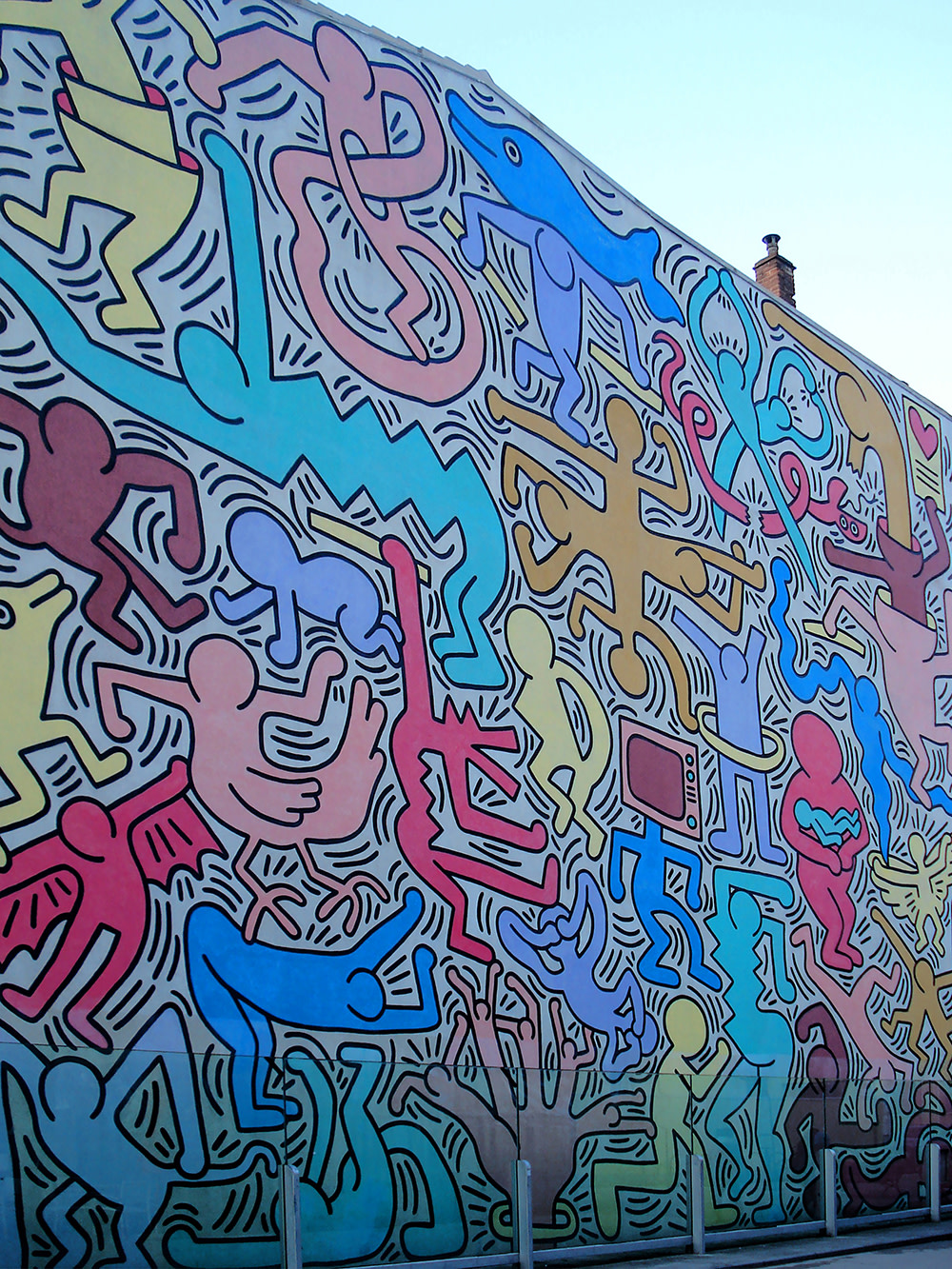 Keith Haring, Tuttomondo, 1989
Keith Haring, Tuttomondo, 1989In addition to the world-famous Piazza dei Miracoli which is a World Heritage Site, the city is home to one of the region’s greatest works of contemporary art: the mural painting Tuttomondo on the wall of the convent beside the Church of Sant’Antonio Abate, which is the last public work by American artist Keith Haring, who died young in 1990 and is now celebrated and admired all over the world. This multicolored combination of different shapes expresses in an original, direct and easily recognizable way, the artist’s message of universal peace and harmony. Because of its iconic nature and linear composition, this great mural “drawing” can be associated with the Museo della Grafica (Graphics Museum) at Palazzo Lanfranchi, the city’ major contemporary art museum, in addition to the prestigious exhibition space Palazzo Blu.
PONTEDERA
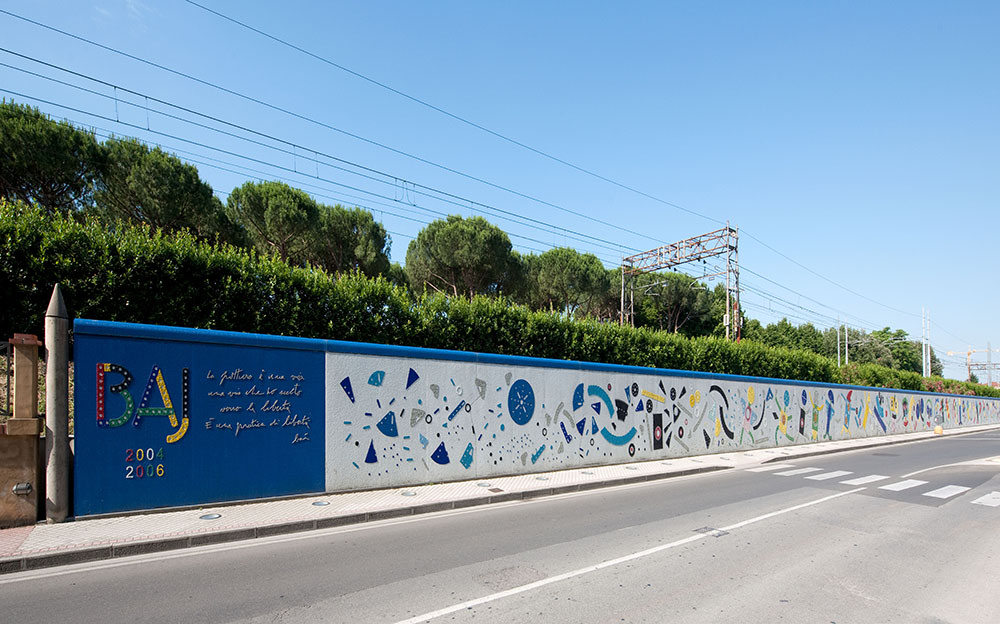 Enrico Baj, Muro di Pontedera, 2004-2006
Enrico Baj, Muro di Pontedera, 2004-2006Valdera Pisana is a high-density contemporary art area, starting with the town of Pontedera, the home of the Piaggio Museum and which, since the eighties, has been offering a wide range of urban artwork: the monumental posthumous mosaic by Enrico Baj on Viale Risorgimento; a sculpture by Nado Canuti on Piazza Garibaldi, where there is also a complete collection of art “chairs”; sculptures by Kan Yasuda along the Tosco-Romagnola road, by Mino Trafeli on Piazza Unità, by Pietro Cascella on Piazza Curtatone, by Giuliano Vangi on Piazza Cavour, by Arturo Carmassi on Viale Europa; all this crowned with the giant lunar “passage” by Mino Trafeli on the Camugliano roundabout in Ponsacco, near Pisa.
PECCIOLI
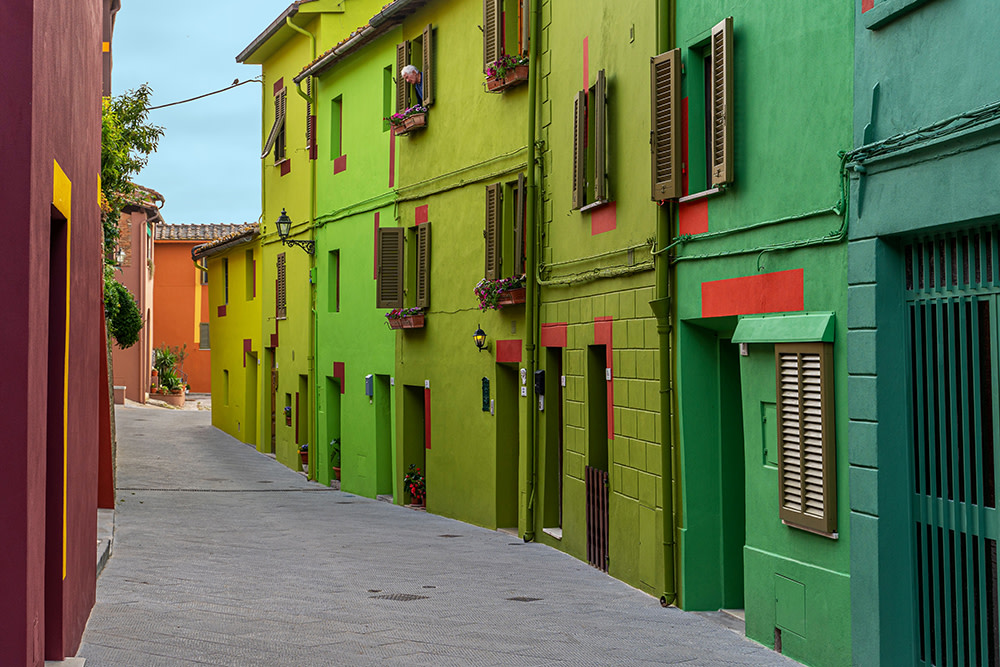 David Tremlett, Via di Mezzo, 2019. Ghizzano
David Tremlett, Via di Mezzo, 2019. GhizzanoIn the nineties, the Valdera area was transformed into an open-air artistic workshop by commissioning artists such as Hidetoshi Nagasawa, Vittorio Messina, Federico De Leonardis, Vittorio Corsini, Nicola Carrino, Alberto Garutti and Remo Salvadori, to create urban installations placed downtown Peccioli, whereas works by the duo Fortuyn/O’Brien and more recent installations by Alicja Kwade, David Tremlett and Patrick Tuttofuoco were specially made for the village of Ghizzano. These works as a whole develop the concept of “the frontier of the contemporary”, symbolically introduced by the roundabout on Via della Fila, at the gates of Peccioli, created by the famous designer Giorgetto Giugiaro.
LAJATICO
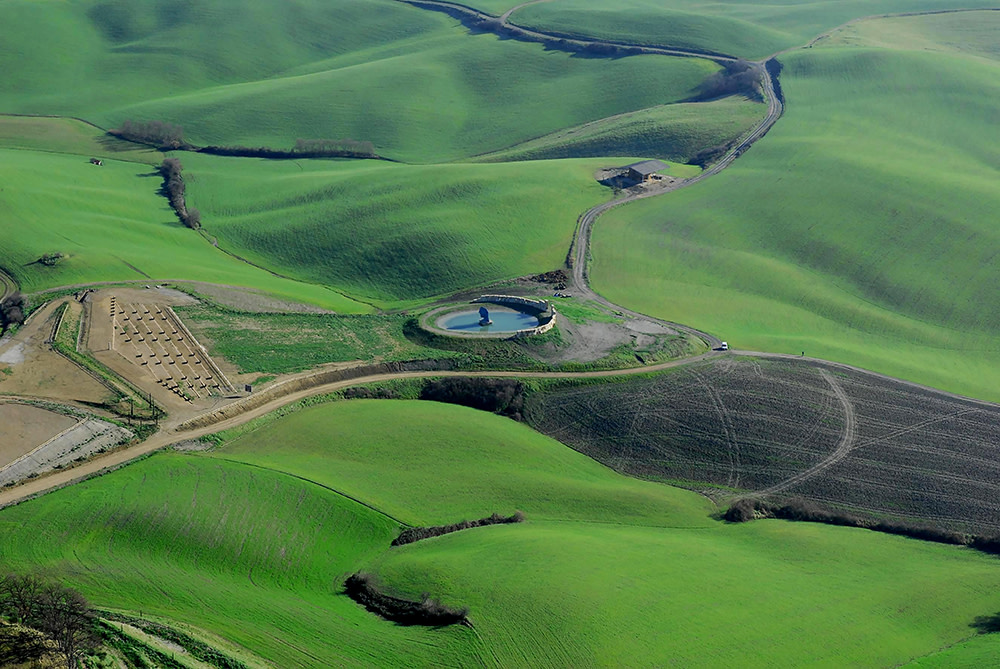 Theater of Silence, 2006-2008
Theater of Silence, 2006-2008In addition to the installation by Mino Trafeli on Piazza San Carlo, the fruit of a regional project devoted to the Tuscan sculptor, the town of Lajatico is home to the Theater of Silence which incorporates the hilly landscape of the Volterra hinterland, a man-made lake surrounded by travertine blocks and the monumental fragment of a “mask” by Igor Mitoraj. The big-sized sculpture is the symbolic centerpiece of this round, open-air theater which comes to life one day a year, on the occasion of an event promoted by the tenor Andrea Bocelli, native of this area, to celebrate the “bel canto” in a breathtaking setting.
VINCI
 Mario Ceroli, L’Uomo di Vinci (The Man of Vinci), 1987
Mario Ceroli, L’Uomo di Vinci (The Man of Vinci), 1987
The Empoli and Valdelsa Fiorentina area include some historic villages “contaminated” by contemporary art, starting with the famous Vinci, Leonardo’s birthplace, where, in the eighties, Mario Ceroli’s version of the Vitruvian Man was placed. As a tribute to Leonardo, a small piazza was designed by Mimmo Paladino, the winner of an international competition to spectacularly connect the two buildings housing the Leonardo Museum, and inaugurated in 2006. In the town, there are also other public tributes to the genius from Vinci, created and donated by international artists such as sculptors Nina Akamu and Wu Weishan, who reinterpreted an unfinished equestrian sculpture by Leonardo and the figure of Leonardo himself.
MONTELUPO
 Ugo La Pietra, Tradizione rinnovata. Sei colonne simboliche, 2016
Ugo La Pietra, Tradizione rinnovata. Sei colonne simboliche, 2016
The town is known for its ceramic production, as can be seen at the local historic Ceramics Museum and the specialist MAIB- Bitossi Artistic Industrial Museum, in addition to the new Atelier of Marco Bagnoli, an established artist who works in this medium too. Montelupo has recently developed a project revolving around ceramic as raw material for contemporary art, with public on-site works: a mural work by Gianni Asdrubali on Via Caverni, a big vase by Bertozzi & Casoni on Via Giro delle Mura, a “sponge” by Loris Cecchini on Piazza XX Settembre, symbolic columns by Ugo La Pietra on Piazza Vittorio Veneto, a double “garden” by Hidetoshi Nagasawa on Piazza VIII Marzo, a “well” by Lucio Perone on Via Tassinari, “televisions” by Fabrizio Plessi in an old kiln. Such original creations have endowed the city with a new identity.
CERTALDO
 Hidetoshi Nagasawa, The Tea House Garden, 2001
Hidetoshi Nagasawa, The Tea House Garden, 2001
This medieval town, known for being Giovanni Boccaccio’s birthplace, is today famous for its annual Festival Mercantia devoted to street theatre. A courtyard of the historic Palazzo Pretorio houses the amazing Tea House Garden by Hidetoshi Nagasawa, the key project of the artistic experience Dopopaesaggio (1996-2002) based on the relations between “social space and natural environment in contemporary art”. The Japanese artist, active in Italy since the sixties, recreated in Certaldo the traditional medieval hortus conclusus, in order to establish an ideal dialogue between Western and Eastern cultures. Other works by the artist are found at Celle and at Villa La Magia.
POGGIBONSI
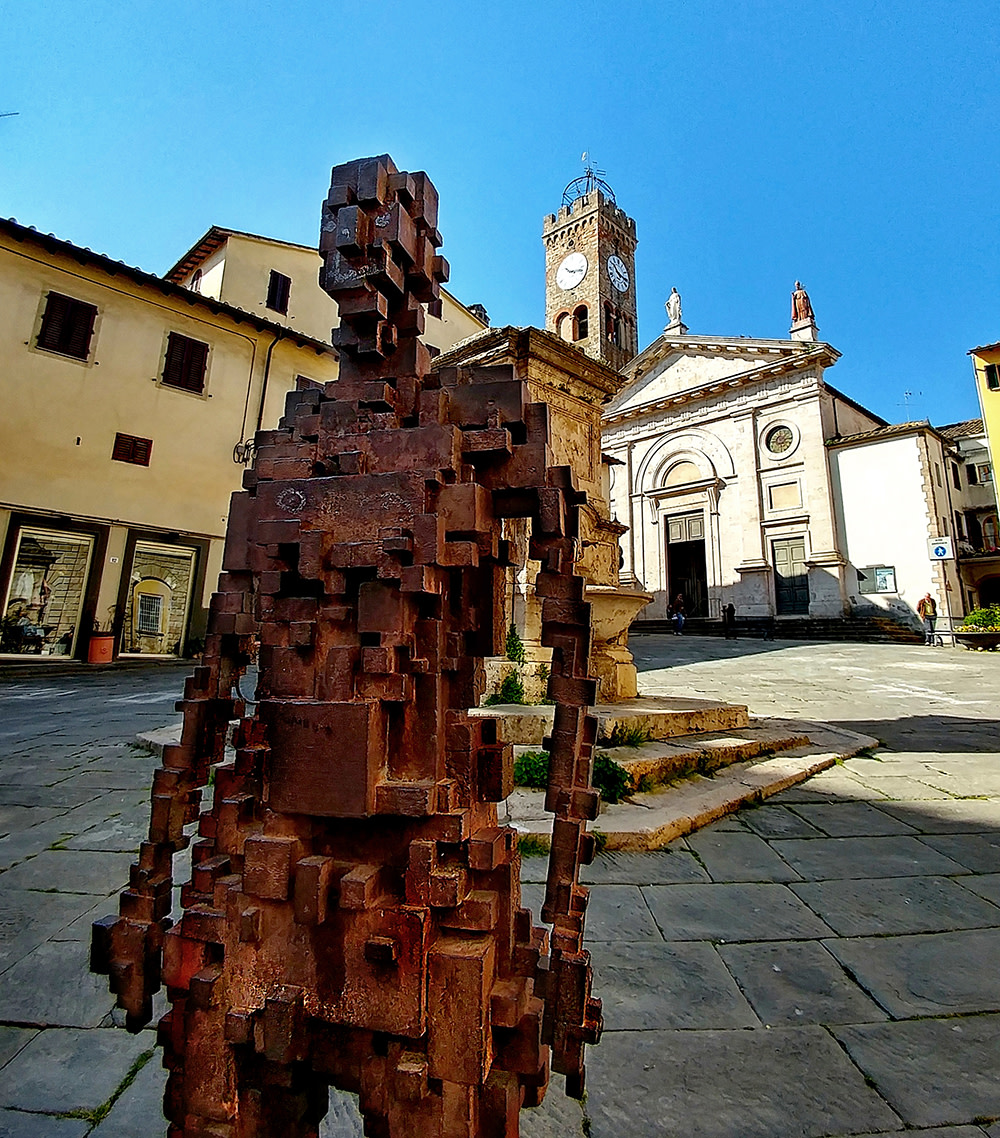 Antony Gormley, Making Space, Taking Place, 2004
Antony Gormley, Making Space, Taking Place, 2004
In the Valdelsa Senese area, the Affinità (1994) and Arte all’Arte (1996-2005) art projects which have encouraged and supported the work by major Italian and international artists for over a decade, have also facilitated the development of public art. In Poggibonsi, an ancient town along the Via Francigena, on the edge of the Chianti area, Antony Gormley scattered a number of pixelated human figures in and around the town, Mimmo Paladino installed symbolic figures in the medieval public fountain Fonte delle Fate, Sarkis created a “relational” fountain on Piazza Matteotti and Kiki Smith placed a “silent” female figure inside the Medicean Fortress.
SAN GIMIGNANO
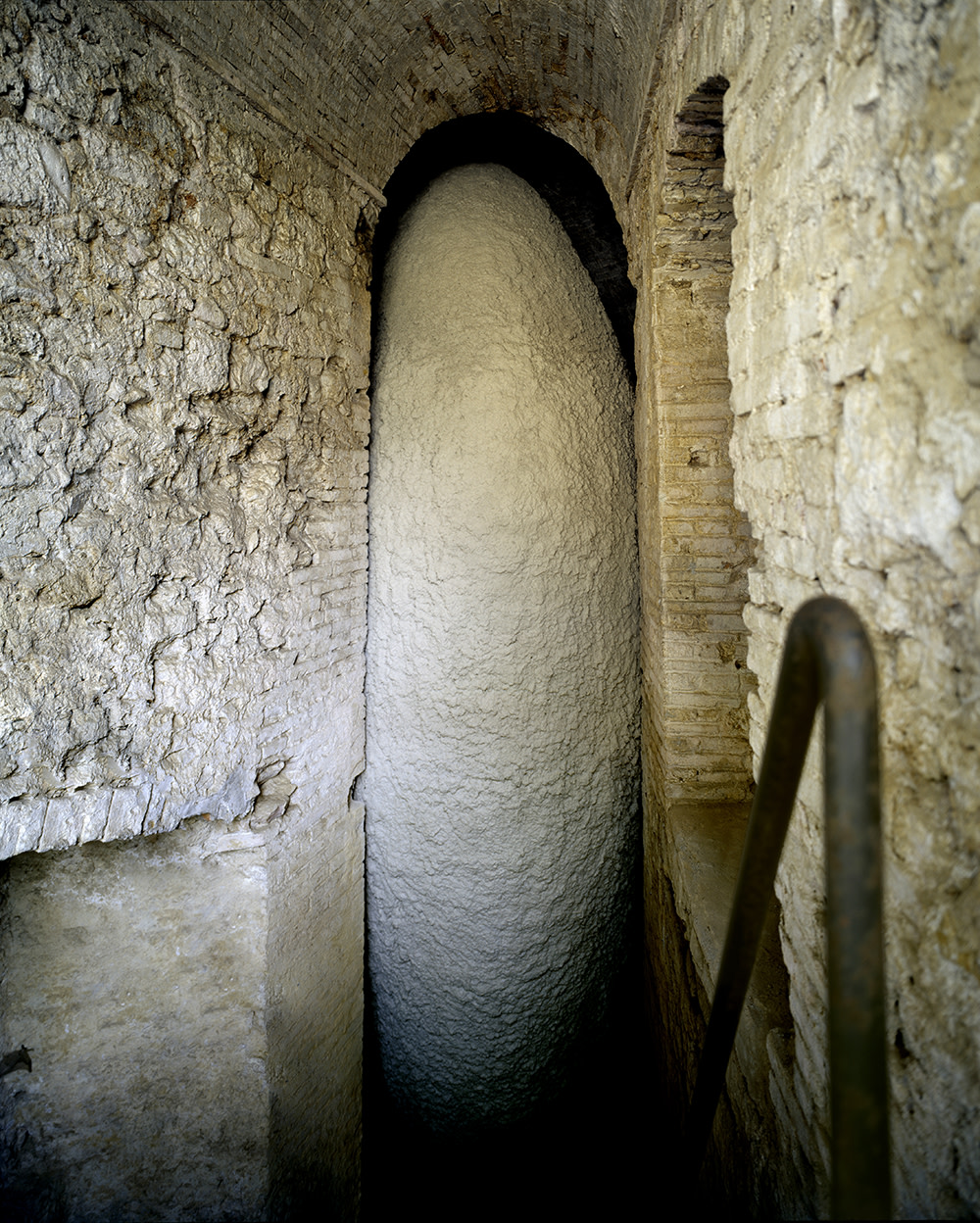 Anish Kapoor, Underground, 2005
Anish Kapoor, Underground, 2005
This medieval town and also World Heritage Site, in addition to the Modern and Contemporary Art Gallery named after the painter Raffaele De Grada, offers installations by great Italian artists created for the Affinità art project: Italia appesa by Luciano Fabro on the Palazzo del Podestà; the bell placed by Jannis Kounellis outside of the Church of San Jacopo; the Sundial designed by Giulio Paolini outside of the Church of Sant’Agostino; the golden vault by Nunzio in the Vicolo dei Bongi; a suspension installation by Eliseo Mattiacci at the Rocca di Montestaffoli. Furthermore, after several years of the international Arte all’Arte event, works by some of the world’s greatest contemporary artists remained permanently: the underground installation by Anish Kapoor at Torrione di Sant’Agostino, another figure by Kiki Smith at Rocca di Montestaffoli, the mosaic by Luisa Rabbia at the Fonte Medievale, the inscription by Joseph Kosuth on Piazza del Bagolaro.
COLLE DI VAL D'ELSA
 Atelier Jean Nouvel with Daniel Buren, Piazza Arnolfo, 2009
Atelier Jean Nouvel with Daniel Buren, Piazza Arnolfo, 2009A town renowned for its crystal production, Colle Val d’Elsa had its main square, Piazza Arnolfo di Cambio, which is named after its most illustrious townsman, restored and renovated to the design of Jean Nouvel, with works by artists Daniel Buren and Alessandra Tesi. Following the international art event Arte all’Arte, the town now houses a number of permanent installations: the memorandum by Alberto Garutti on Via Meoni; Marisa Merz’s work on the door of an ancient cistern at the entrance to the town; the column by Ilya Kabakov at the Bastione della Sapia; the UMoCA project by Cai Guo-Qiang and a figure by Kiki Smith beneath the bridge Ponte San Francesco; Tadashi Kawamata’s installation at the Porta Nuova gate; the Sonar project by Loris Cecchini in the Molinuzzo area.
SIENA
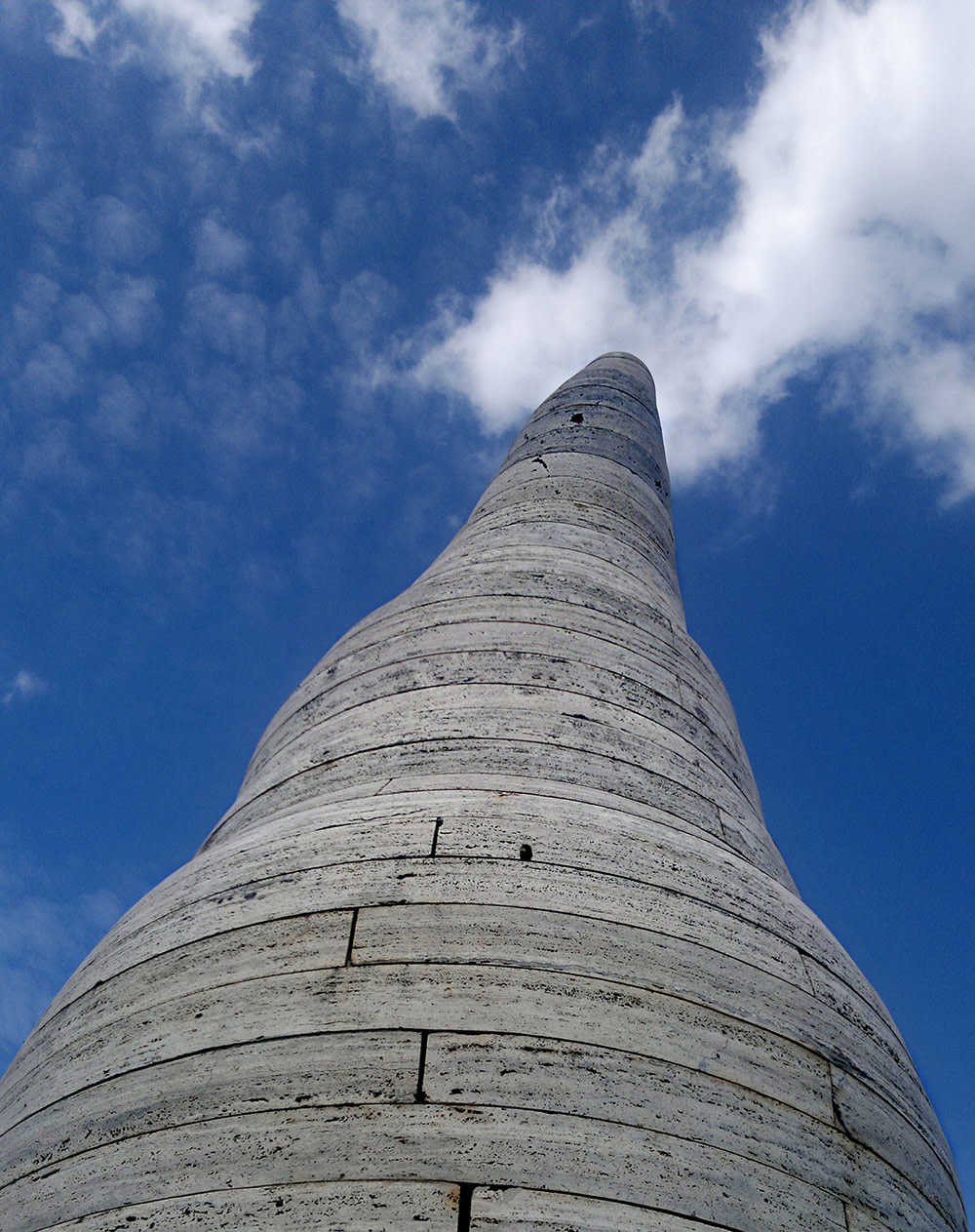 Tony Cragg, The Drop, 1998
Tony Cragg, The Drop, 1998A city with a deeply rooted historical-artistic identity, named as World Heritage Site and closely tied to the Palio tradition, Siena houses a major public work by Tony Cragg, considered to be one of the leading exponents of postmodern sculpture. Placed in the lovely panoramic setting of the Orto de’ Tolomei, The Drop was created on the occasion of the artist’s exhibition at the Santa Maria della Scala complex: a sculpture formed by overlapping layers of travertine which create the perfect sedimentation, carved in time. Stone and its layerings are evocative of the land and of man’s hard work to mould it into a shape.
CHIANTI
 Mario Merz, Senza Titolo, 1997:1999. San Casciano Val di Pesa
Mario Merz, Senza Titolo, 1997:1999. San Casciano Val di Pesa
Renowned all over the world for the beauty of its landscape, the Chianti area houses permanent works created for the Tuscia Electa art event (1996-2010), aimed at rethinking the Tuscan landscape through works of contemporary art. San Casciano Val di Pesa houses an original installation by Mario Merz, a bright presence above the ancient walls, a monumental criss-cross of “stalks” by Mauro Staccioli on Via Cassia in the direction of Florence; a monolithic Stollo by Mauro Staccioli is found on Piazza della Biblioteca in Greve in Chianti; in Impruneta, Alan Sonfist designed an installation for the olive grove near the ancient Poggi kiln, in the archetypical shape of an olive leaf made by using terracotta tiles.






